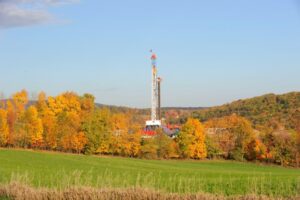By John Rutecki
Earlier this summer, EDF, Boston University School of Public Health, the University of North Carolina at Chapel Hill’s Institute for the Environment and PSE Healthy Energy published a peer-reviewed study that quantified the health impacts of oil and gas pollution, both in dollar value and human lives. The study found that in 2016 alone, pollution from oil and gas production caused $77 billion in health damages across the U.S and thousands of early deaths. Appalachian states had some of the highest health damage rates, especially on a per capita basis. Across Pennsylvania, Ohio and West Virginia there were over 1,000 deaths from oil and gas pollution, with some of the highest rates of childhood asthma exacerbations in the country.
Oil and gas methane rules from the EPA — and strong state implementation plans — offer a critical opportunity to safeguard the health of our communities while growing the economy and creating family sustaining jobs. Curbing methane pollution from oil and gas is also the fastest, most cost-effective way to slow the current rate of climate change while protecting public health.
New health study shows cost of oil and gas pollution in Appalachia Share on XAn enormous toll on the health of communities
The study found that Pennsylvania had 605 deaths in one year from oil and gas pollution, the highest total in the region and the second most in the U.S. after Texas. Pennsylvania also had the third highest total childhood asthma exacerbations in the country, with 36,700. West Virginia had 196 total deaths and 10,100 asthma exacerbations among children, with some of the highest rates per million in the U.S. West Virginia had the second highest deaths per million, 152, and the third highest rate of childhood asthma exacerbations per million with 36,800. Ohio also placed in the top 20% of states for total health impacts, with 349 total deaths and 15,500 total asthma exacerbations among children.
This study comes shortly after the American Lung Association’s annual State of the Air report, which grades counties on their levels of ozone and particulate pollution. Methane co-pollutants contribute to the formation of ground-level ozone, which can worsen a host of respiratory and cardiac diseases. Four counties in Ohio received failing grades from the ALA for ozone pollution, including Cuyahoga and Lake counties, which have oil and gas production. In Pennsylvania, Philadelphia and Bucks counties in southeastern Pennsylvania both received failing grades. While the Philly region doesn’t have any substantial oil and gas production, the study found that even cities far away from production still had serious health impacts that could be tied to methane pollution.
“The fact that air pollution and health impacts cross state boundaries indicates a strong need for regional to nationwide coordination,” says study senior author Saravanan Arunachalam, research professor and deputy director at UNC-IE.
Benefits of cutting methane pollution
It’s clear that we need to reduce methane emissions now. Cutting methane protects public health and comes with many other benefits: slowing the current rate of climate change, reducing methane waste, and job creation.
People living in Pennsylvania, Ohio and West Virginia are already feeling the impacts of climate change. We’ve experienced hotter, longer summers and increasingly severe weather. Hotter summers can contribute to the formation of ground-level ozone, or smog, further exacerbating the health impacts of methane emissions. Warmer temperatures also increase the risk of vector-borne diseases, like Lyme disease. Pennsylvania has had the highest rates of Lyme disease in the country for 11 of the past 12 years, with cases rising in neighboring states.
Large amounts of methane in the form of natural gas are wasted every year. Currently, $2 billion worth of methane is emitted from U.S. oil and gas operations — enough to meet the annual gas needs of 3.4 million homes. The technology exists to reduce these emissions and it’s already in use throughout Appalachia. Between Pennsylvania, Ohio and West Virginia, there are 52 methane mitigation companies doing business in the region and 13 company headquarters. Stronger methane regulations will boost these businesses and bring jobs to Appalachia.
Investing in methane mitigation is essential for keeping Appalachian states competitive in an energy market where investors and consumers are demanding cleaner products. Many industry leaders operating in Appalachia recognize and support the need for methane emission reductions. In order for Pennsylvania, Ohio and West Virginia to remain tomorrow’s energy leaders, policymakers must take meaningful steps to reduce methane emissions.
Supporting strong federal and state methane emission protections are clear opportunities for policymakers to do just that. Later this year, the EPA is expected to finalize a proposal to reduce methane pollution from oil and gas operations. This commonsense proposal will require inspections at all wellsites, including low-producing wells. Research suggests that low-producing wells produce just 6% of the nation’s oil and gas, but contribute half of all wellsite methane emissions. In Appalachian states, 90-95% of all wells are low-producing. The current proposal also phases out pollution from new and existing pneumatic controllers, which collectively make up the second largest source of methane pollution. Industry leaders are supportive of these new protections and some are already taking steps to implement them. Pittsburgh-based EQT — the nation’s largest natural gas producer — recently transitioned to all zero-emitting pneumatics.
It’s important that the EPA finalizes these rules quickly, so states can craft their State Implementation Plans to reduce methane emissions and protect public health and local economies. The data shows that there’s no time to waste.










